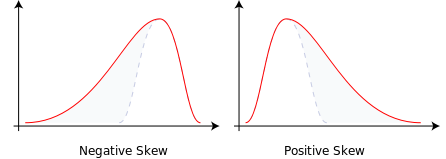Difference between revisions of "Shapes of distribution"
(Created page with "Distribution of data can take a wide variety of shapes, and ultimately depends on how data points are distributed along the measurement scale. A general "feel" for the data c...") |
(→Normal (bell-shaped) distribution) |
||
| Line 7: | Line 7: | ||
== Normal (bell-shaped) distribution == | == Normal (bell-shaped) distribution == | ||
| + | When the collected data tends to hover around a central value, with no bias to the left or the right, the data creates a Normal distribution. | ||
| + | This Normal distribution is also referred to as the "Bell Curve" because it resembles a bell like shape. | ||
| + | |||
| + | When stating that data is normally distributed we are identifying that 50% of the values are less than the mean and that 50% of the values are greater than the mean. In a normal distribution the mean, median, and mode are equal to one another. | ||
| + | |||
| + | Examples of data that follow a normal distribution could include blood pressure and scores on a test. | ||
| + | |||
| + | ''contributed by, Scott Trungadi'' | ||
== Skewness == | == Skewness == | ||
Revision as of 16:44, 23 September 2019
Distribution of data can take a wide variety of shapes, and ultimately depends on how data points are distributed along the measurement scale. A general "feel" for the data can be achieved by examining the uniformity (or lack thereof) of a distribution. In general, the larger the sample size, the more symmetrical the distribution.
Uniform distribution
Normal (bell-shaped) distribution
When the collected data tends to hover around a central value, with no bias to the left or the right, the data creates a Normal distribution. This Normal distribution is also referred to as the "Bell Curve" because it resembles a bell like shape.
When stating that data is normally distributed we are identifying that 50% of the values are less than the mean and that 50% of the values are greater than the mean. In a normal distribution the mean, median, and mode are equal to one another.
Examples of data that follow a normal distribution could include blood pressure and scores on a test.
contributed by, Scott Trungadi
Skewness
Skewed right Skewed left
Acceptable skewness values: -1.000 < skewness < 1.000
Examining the data skewness allows you to see the variability of a data set. Skewness is when a data set does not follow the normal distribution. A normal distribution has a skewness of zero, and will have perfect symmetry. Data that is positively skewed will be skewed to the right and will be a positive number; data that is negatively skewed is skewed to the left of the data mean, and is a negative number. See an example of skewness, below.
"contributed by Cassandra Cosentino"
Kurtosis
Leptokurtic Platykurtic
Acceptable kurtosis values : -1.000 < kurtosis < 1.000
